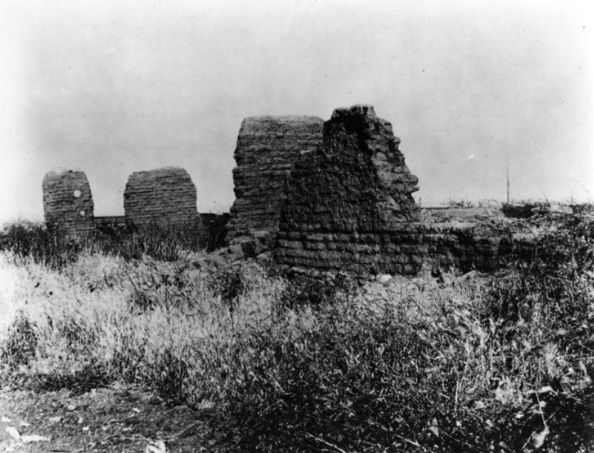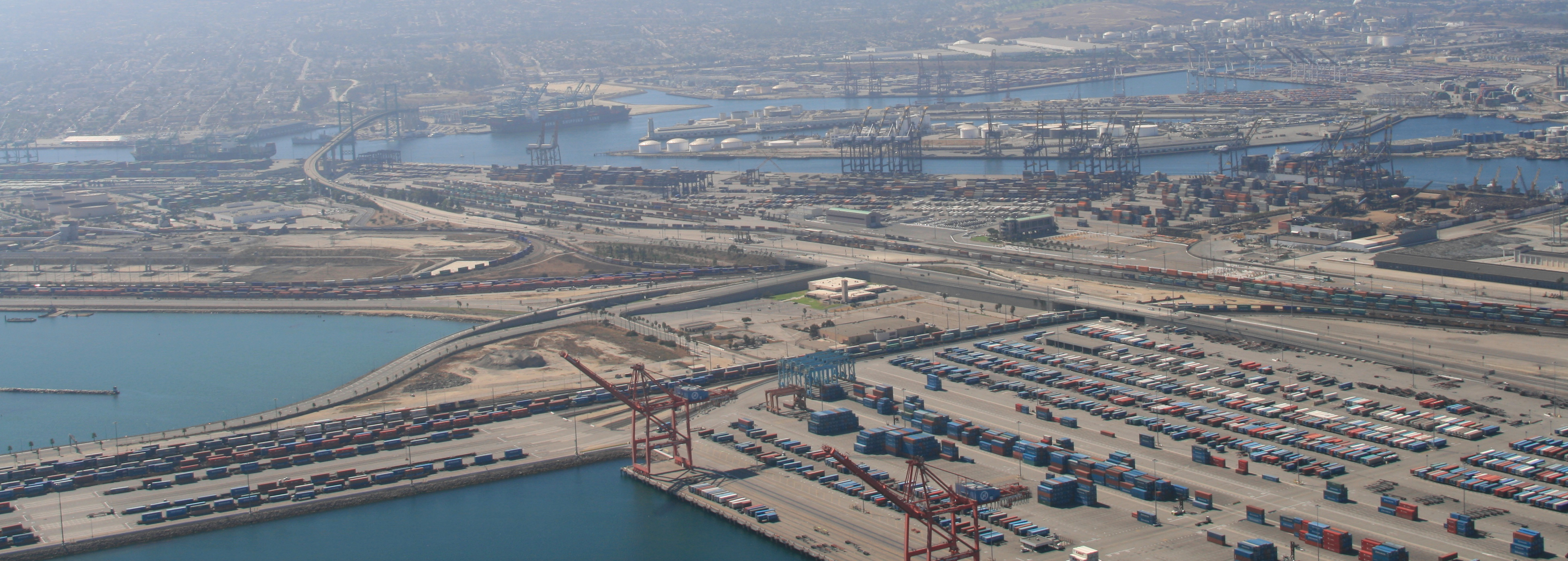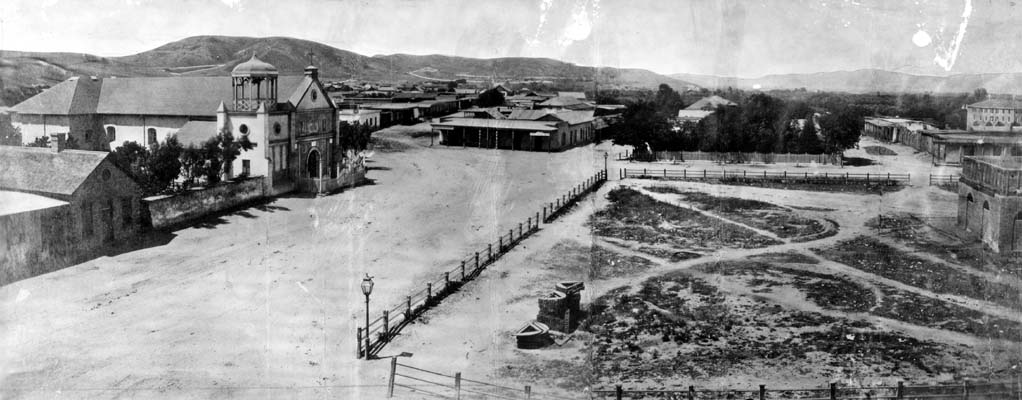|
Casa De San Pedro
Casa de San Pedro was a hide house and one of the oldest commercial structure on the San Pedro Bay. Its site was designated a California Historic Landmark, No. 235, on June 6, 1978. The site is now near Meyler St. and Quartermaster Road in San Pedro. McCulloch and Hartnell built the structure to store cattle hides purchased from the Mission San Gabriel Arcángel and San Fernando mission. In 1829 the Casa was sold to Mission San Gabriel. In 1834 the Casa was sold to Abel Stearns. Stearns established a stagecoach route connecting San Pedro Bay with the Pueblo de Los Ángeles. Casa de San Pedro is described as an adobe hide house is the book ''Two Years Before the Mast'' by Richard Henry Dana published in 1840. Casa de San Pedro was part of the began of the Port of Los Angeles. In 1846 the Mexican governor of Alta California, Pío Pico, directed that a 500-vara-square of land (43 acres) facing onto San Pedro Bay be set aside as a government reservation. In 1904 surveyor H.H. Burto ... [...More Info...] [...Related Items...] OR: [Wikipedia] [Google] [Baidu] |
Fort MacArthur
Fort MacArthur is a former United States Army installation in San Pedro, Los Angeles, California (now the port community of Los Angeles). A small section remains in military use by the United States Air Force as a housing and administrative annex of Los Angeles Air Force Base. The fort is named after Lieutenant General Arthur MacArthur. His son, Douglas MacArthur, would later command American forces in the Pacific during World War II. History In 1888, President Grover Cleveland designated an area overlooking San Pedro Bay as an unnamed military reservation intended to improve the defenses of the expanding Los Angeles harbor area. Additional land was purchased in 1897 and 1910, and Fort MacArthur was formally created on October 31, 1914. The fort was a training center during World War I, and the first large gun batteries for harbor defense were installed in 1917. The effectiveness of these fixed gun emplacements was debated for many years, and test firings were extremely unpopu ... [...More Info...] [...Related Items...] OR: [Wikipedia] [Google] [Baidu] |
Two Years Before The Mast
''Two Years Before the Mast'' is a memoir by the American author Richard Henry Dana Jr., published in 1840, having been written after a two-year sea voyage from Boston to California on a merchant ship starting in 1834. A film adaptation under the same name was released in 1946. The journey Outbound In the book, which takes place between 1834 and 1836, Dana gives a vivid account of "the life of a common sailor at sea as it really is". He sails from Boston to South America and around Cape Horn to California. Dana's ship was on a voyage to trade goods from the United States for the Mexican colonial Californian California missions' and ranchos' cow hides. They traded at the ports in San Diego Bay, San Pedro Bay, Santa Barbara Channel, Monterey Bay, and San Francisco Bay. The provenance of this history is well supported by records showing the company of Sprague and James building and launching a ship named ''Pilgrim'' in 1825 in Medford, Massachusetts. California Dana arrived in ... [...More Info...] [...Related Items...] OR: [Wikipedia] [Google] [Baidu] |
List Of California Ranchos
These California land grants were made by Spanish (1784–1821) and Mexican (1822–1846) authorities of Las Californias and Alta California to private individuals before California became part of the United States of America.Shumway, Burgess M.,1988, ''California Ranchos: Patented Private Land Grants Listed by County'', The Borgo Press, San Bernardino, CA, Under Spain, no private land ownership was allowed, so the grants were more akin to free leases. After Mexico achieved independence, the Spanish grants became actual land ownership grants. Following the Mexican–American War, the 1848 Treaty of Guadalupe Hidalgo provided that the land grants would be honored. Alta California ranchos in Mexico From 1773 to 1836, the border between Alta California and Baja California was about 30 miles south of the Mexico–United States border drawn by the Treaty of Guadalupe Hidalgo that ended the Mexican–American War in 1848. Under the Siete Leyes constitutional reforms of 1836, the Alt ... [...More Info...] [...Related Items...] OR: [Wikipedia] [Google] [Baidu] |
California Historical Landmarks In Los Angeles County
List table of the properties and districts — listed on the California Historical Landmarks in Los Angeles County, Southern California. :*Note: ''Click the "Map of all coordinates" link to the right to view a Google map of all properties and districts with latitude and longitude coordinates in the table below.'' See also *List of California Historical Landmarks * National Register of Historic Places listings in Pasadena, California *National Register of Historic Places listings in Los Angeles County, California *National Register of Historic Places listings in Los Angeles, California This is a List of the National Register of Historic Places in the city of Los Angeles. (For those in the rest of Los Angeles County, go here.) Current listings :' ... References {{DEFAULTSORT:Californ ... [...More Info...] [...Related Items...] OR: [Wikipedia] [Google] [Baidu] |
Surveying
Surveying or land surveying is the technique, profession, art, and science of determining the terrestrial two-dimensional or three-dimensional positions of points and the distances and angles between them. A land surveying professional is called a land surveyor. These points are usually on the surface of the Earth, and they are often used to establish maps and boundaries for ownership, locations, such as the designed positions of structural components for construction or the surface location of subsurface features, or other purposes required by government or civil law, such as property sales. Surveyors work with elements of geodesy, geometry, trigonometry, regression analysis, physics, engineering, metrology, programming languages, and the law. They use equipment, such as total stations, robotic total stations, theodolites, GNSS receivers, retroreflectors, 3D scanners, LiDAR sensors, radios, inclinometer, handheld tablets, optical and digital levels, subsurface locators, d ... [...More Info...] [...Related Items...] OR: [Wikipedia] [Google] [Baidu] |
Pío Pico
Don Pío de Jesús Pico (May 5, 1801 – September 11, 1894) was a Californio politician, ranchero, and entrepreneur, famous for serving as the last governor of California (present-day U.S. state of California) under Mexican rule. A member of the prominent Pico family of California, he was one of the wealthiest men in California at the time and a hugely influential figure in Californian society. His legacy can be seen in the numerous places named after him, such as the city of Pico Rivera, Pico Boulevard in Los Angeles, Pio Pico State Historic Park, and the numerous schools that bear his name. Early years Pico, a member of the prominent Pico family of California, was born at Mission San Gabriel Arcángel to José María Pico and his wife María Eustaquia Gutiérrez, with the aid of midwife Eulalia Pérez de Guillén Mariné. His paternal grandmother, María Jacinta de la Bastida, was listed in the 1790 census as ''mulata'', meaning mixed race with African ancestry. His patern ... [...More Info...] [...Related Items...] OR: [Wikipedia] [Google] [Baidu] |
Port Of Los Angeles
The Port of Los Angeles is a seaport managed by the Los Angeles Harbor Department, a unit of the City of Los Angeles. It occupies of land and water with of waterfront and adjoins the separate Port of Long Beach. Promoted as "America's Port", the port is located in San Pedro Bay in the San Pedro and Wilmington neighborhoods of Los Angeles, approximately south of downtown. The cargo coming into the port represents approximately 20% of all cargo coming into the United States. The port's channel depth is . The port has 25 cargo terminals, 82 container cranes, 8 container terminals, and of on-dock rail. The port's top imports were furniture, automobile parts, apparel, footwear, and electronics. In 2019, the port's top exports were wastepaper, pet and animal feed, scrap metal and soybeans. As of a report from the port released 2020, its top three trading partners were China (including Hong Kong), Japan, and Vietnam. As of 2022, the port, together with the adjoining Port of Lon ... [...More Info...] [...Related Items...] OR: [Wikipedia] [Google] [Baidu] |
Pueblo De Los Ángeles
El Pueblo de Nuestra Señora la Reina de los Ángeles (English language, English: ''The town of Our Lady the Queen of the Angels''), shortened to Pueblo de los Ángeles, was the Spanish civilian ''Municipality, pueblo'' settled in 1781, which by the 20th century became the American metropolis of Los Angeles. The pueblo was built using labor from the adjacent village of Yaanga and was totally dependent on local Indigenous peoples of California, Indigenous labor for its survival. Official settlements in Alta California were of three types: ''presidio'' (military), ''Spanish missions in California, mission'' (religious) and ''pueblo'' (civil). The Pueblo de los Ángeles was the second pueblo (town) created during the Spanish colonization of the Americas, Spanish colonization of California (the first was History of San Jose, California#First Spanish pueblo in California San José/, San Jose, in 1777). —'The Town of the Queen of Angels' was founded twelve years after the first '' ... [...More Info...] [...Related Items...] OR: [Wikipedia] [Google] [Baidu] |
San Pedro, Los Angeles
San Pedro ( ; Spanish: " St. Peter") is a neighborhood within the City of Los Angeles, California. Formerly a separate city, it consolidated with Los Angeles in 1909. The Port of Los Angeles, a major international seaport, is partially located within San Pedro. The district has grown from being dominated by the fishing industry, to a working-class community within the city of Los Angeles, to a rapidly gentrifying community. History The peninsula, including all of San Pedro, was the homeland of the Tongva-Gabrieleño Native American people for thousands of years. In other areas of the Los Angeles Basin archeological sites date back 8,000–15,000 years. The Tongva believe they have been here since the beginning of time. Once called the "lords of the ocean", due to their mastery of oceangoing canoes (Ti'ats), many Tongva villages covered the coastline. Their first contact with Europeans was in 1542 with Juan Rodríguez Cabrillo, the Spanish explorer who also was the first to writ ... [...More Info...] [...Related Items...] OR: [Wikipedia] [Google] [Baidu] |
Stagecoach
A stagecoach is a four-wheeled public transport coach used to carry paying passengers and light packages on journeys long enough to need a change of horses. It is strongly sprung and generally drawn by four horses although some versions are drawn by six horses. Commonly used before steam-powered rail transport was available, a stagecoach made long scheduled trips using ''stage stations'' or posts where the stagecoach's horses would be replaced by fresh horses. The business of running stagecoaches or the act of journeying in them was known as staging. Some familiar images of the stagecoach are that of a Royal Mail coach passing through a turnpike gate, a Dickensian passenger coach covered in snow pulling up at a coaching inn, a highwayman demanding a coach to "stand and deliver" and a Wells Fargo stagecoach arriving at or leaving a Wild West town. The yard of ale drinking glass is associated by legend with stagecoach drivers, though it was mainly used for drinking feats and ... [...More Info...] [...Related Items...] OR: [Wikipedia] [Google] [Baidu] |
Abel Stearns
Abel Stearns (February 9, 1798 – August 23, 1871) was an American trader who came to the Pueblo de Los Angeles, Alta California in 1829 and became a major landowner and cattle rancher and one of the area's wealthiest citizens. Early life Stearns was born in Lunenburg, Massachusetts, the son of Elizabeth (née Goodrich) and Levi Stearns, a farmer. His parents were both from families that came from England in the 1600s. In about 1826 he went to Mexico, where he became a naturalized citizen. Los Angeles In 1829, Stearns emigrated to Monterey, California, and then settled in the Pueblo de los Ángeles in present day Los Angeles, California. He obtained a government concession to build a warehouse at San Pedro, the nearest seaport. Later, he established a stagecoach route connecting San Pedro Bay with the Los Angeles pueblo. In 1831, he built a three-story flour mill on North Spring Street, Los Angeles. Soon, Stearns became one of the most prominent and influential citizens of ... [...More Info...] [...Related Items...] OR: [Wikipedia] [Google] [Baidu] |



_crop.jpg)
.jpg)



.jpg)